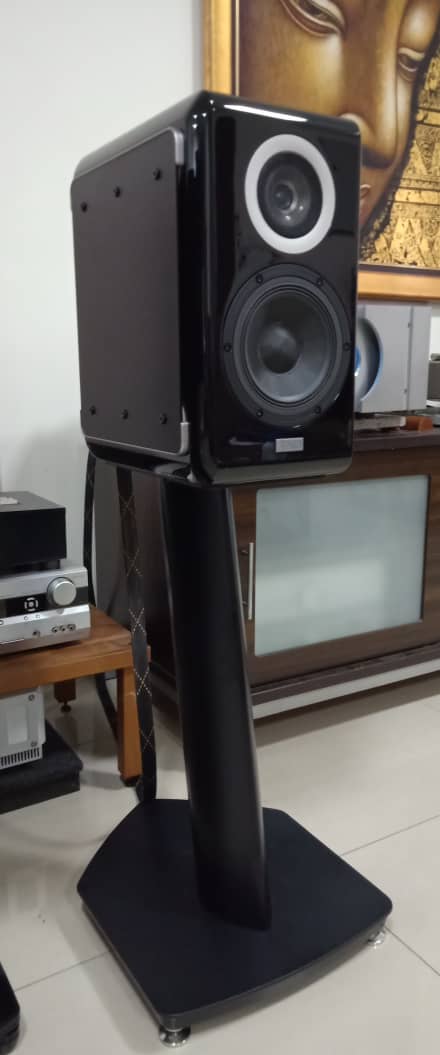
All of its vertical surfaces are curved, the flat top panel slopes upward toward the rear, and the front baffle is raked back to meet the tweeter module at an angle - in short, the front baffle is folded slightly inward. The Sopra No1’s cabinet is unique, and quite attractive on close inspection, with immaculate fit and finish - which is the least you should expect in a minimonitor costing ten grand per pair. This stabilizes the dynamic behavior of the surround, which, according to Focal, avoids deformation of the cone without impeding dynamics. Two tubular rings are incorporated into the surround to provide additional mass to oscillate in opposition to the cone’s resonant frequency. The entire tweeter assembly is isolated in a separate trapezoidal enclosure, made of inert injected polyurethane for optimal mass and damping, that sits atop the main cabinet.Īnother patented technology found in the Sopra No1 is Focal’s Tuned Mass Damper (TMD) cone surround, designed to control the cone breakup that occurs when a diaphragm resonates uncontrollably. As a result, the tweeter’s acoustic impedance approaches zero, which means that there’s virtually no resistance to affect the dome’s intended movements and thus the fidelity of its reproduction within its bandwidth. The horn is filled with a damping material that delicately and gradually absorbs the tweeter’s rear-radiated soundwaves. The Sopra models’ inverted beryllium domes are mounted in Focal’s unique patented Infinite Horn Loading (IHL) system - essentially, the rear of the tweeter is loaded via a small cavity, which is connected to the exterior of the speaker enclosure by a horn. Beryllium is seven times more rigid than titanium or aluminum, and this, Focal claims, makes it possible for their Be tweeters to reproduce a very wide bandwidth of 1-40kHz. Et voilà: double glass = double verre = double V = W. Why is it called W? In English, the name of the letter W is double U in French, it’s double V. They claim that the resulting sound is entirely transparent, with excellent phase response and very low distortion. Varying the thickness of the foam core and the number of glass fibers allows Focal to optimally match the cone’s behavior to its assigned bandwidth. Focal claims that the glass tissue, finely woven of very long fibers, provides a perfect blend of damping, lightness, and rigidity - they say it’s 20 times as rigid as cones woven of Kevlar or aramid. The cone comprises two sheets of woven glass tissue sandwiching a structural core of foam.
#Tad speakers price list drivers
All Sopra models have cone drivers made of Focal’s patented W material, and all of their tweeters are Focal-made inverted domes of pure beryllium.įocal’s W cones are also found in Focal’s top line, the Utopia models, and have some noteworthy features.
#Tad speakers price list driver
The No1’s 1” tweeter is crossed over to its 6.5” bass-midrange driver at 2.2kHz. The matching stand is 24”H and weighs almost as much: 41 pounds. The Sopra No1 is a rather large, curved minimonitor standing 16.5”H x 11”W x 15.5”D and weighing 42 pounds. I requested a pair of Sopra No1s for review, along with their matching stands ($1980/pair), and they arrived in the flashiest finish imaginable: Chameleon (see below). Though late to the Sopra party, I’m a big fan of minimonitors, and have been itching to listen to the No1s in my room ever since September 2019, when I reviewed and thoroughly enjoyed Focal’s Spectral 40th floorstander ($9999/pair). Then, in 2016, Focal released a larger floorstander, the Sopra No3 ($23,990/pair), as well as the Sopra Center ($3990 each) and the Sopra Surround BE ($6990/pair). In October 2015, Doug Schneider reviewed the Sopra No2 and liked it so much that it was named a Reviewers’ Choice. In May 2015, Focal introduced their Sopra line of loudspeakers with the Sopra No1 minimonitor ($9990/pair, all prices USD) and the Sopra No2 floorstander ($18,990/pair).

Note: Measurements taken in the anechoic chamber at Canada's National Research Council can be found through this link.


 0 kommentar(er)
0 kommentar(er)
